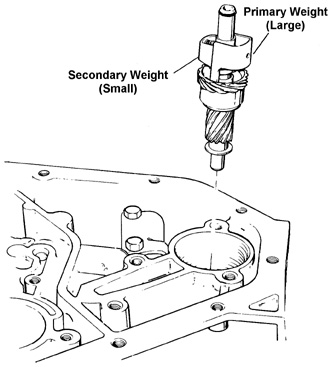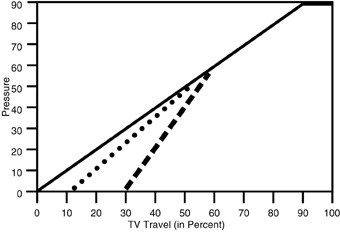

I
t's no secret that my favorite overdrive transmission for street racing is the 200-4R. The purpose of this article is not to say that we at ATRA condone this type of illegal activity, but we're pretty sure people are going to continue. And I've always felt that if you're going to do something, right or wrong, you may as well do it right. So in this article, we're going to look at ways to eliminate most of the driveability quirks, and at the same time, keep the performance feel.With so many different combinations of engine parts, such as cams and intake manifolds to name just a couple, it's very unlikely that one type of modification will work in every application. Whether you buy a box of colored springs to get in the ballpark or start with a stock valve body, one thing is very clear: With a high performance engine, you will need to fine-tune the valve body to get maximum performance from the vehicle.
When a high performance engine is done right, you can pick up a lot of performance by keeping the engine within its RPM performance range. For example: if a big block 454 stops developing power above 6500 RPM, you can't have the transmission holding the full throttle 12 upshift to 6700 RPM. There's far more vehicle performance to be gained with shift timing, rather than shift feel. So in this article we'll deal with shift timing modifications, and leave the hard shifts for another time.
The hardest part about fine tuning the 200-4R, especially for street use is there are so many valves to work with. Each of these valves offer a slightly different way to modify shift timing. For example, if you want to delay upshifts, you could work with the governor, TV adjustment, MTV up, or the individual shift valve springs. The valve you choose depends on exactly how you want to delay your upshift.
Understanding the function of these valves will help you make this decision. I know that some of you don't care about how each valve functions, but quite frankly, if you want to build a transmission for a fast car, you need to step up to the plate. Could you just imagine if the John Force crew chief, Austin Coil, said, "I don't know how fuel injection works ... I just tune it." I will however, try to keep it short, to the point, and leave out as much math homework as I can. Keep in mind that while most of these principles also apply to many different transmissions, some may not. Throughout this article, I am writing about the 2004R only.
Basics:
Governor pressure is acting on one side of the shift valves, trying to force the valves toward the upshifted position, while all other pressures, such as shift valve spring tension, MTV pressure, and detent pressure are trying to force the shift valve toward the downshifted position.Governor:
Modifying governor pressure changes all upshift and downshift timings. Raising governor pressure makes all upshifts and downshifts occur at lower vehicle speeds. Lowering governor pressure makes all upshifts and downshifts occur at higher vehicle speeds. You can alter the governor pressure by changing the size of the small governor weight or the spring tension on the small governor weight (figure 1).
Figure 1
Modifying the spring tension tends to have a greater effect on governor pressure at lower vehicle speeds rather than higher speeds. A lighter spring lowers governor pressure and a heavier spring increases governor pressure.
Modifying the governor weights tends to change governor pressure at all vehicle speeds above 510 MPH. A lighter weight lowers governor pressure and a heavier weight increases pressure at any given vehicle speed.
If you want to make any other shift timing modifications you'll have to make them in the valve body. Figure two shows all of the valves we'll discuss here.
Throttle Valve:
There is only one adjustment for the TV cable. You should set it to maximum at full throttle and then leave it alone. Make all other shift timing and shift feel adjustments with valve body or governor modifications.If this vehicle did not originally have a 2004R in it, the TV cable may not be properly calibrated or set up for this vehicle. If this is the case on the car you're working on, there is an excellent "Ask The Experts" article in GEARS, May 1997 that shows how to check and correct TV cable installation and calibration problems.
Shift Valve Springs:
Shift valve springs tend to control upshift and downshift timing at light throttle opening, while having a slight effect on the medium-to-full throttle shifts. A heavier spring will raise the upshift and downshift speeds while a lighter spring will lower the upshift and downshift speeds. The main reason to modify this spring is to modify one particular shift. For example, if you want to lower the 23 upshift but leave the 12 and the 34 alone, replace the 23 shift valve spring with a lighter one.MTV Up:
This valve determines two things: First, the valve blocks TV pressure from getting to any of the shift valves until TV pressure is high enough to move the MTV Up valve. Once this happens, the MTV Up valve regulates TV pressure. The MTV Up valve controls the sensitivity of the light-to-medium upshifts. A heavier MTV Up spring makes the light-to-medium upshifts earlier. A lighter MTV Up spring makes the light-to-medium upshifts later. Once the shift valve upshifts, the shift valve blocks MTV Up pressure, so it no longer controls the shift valve.MTV Down:
This valve also determines two things: First the valve blocks TV pressure from getting to any of the shift valves--except the 1-2 shift valve--until TV pressure is high enough to move the MTV Down valve. Once this happens the MTV Down valve regulates TV pressure. The MTV Down valve controls the sensitivity of the light-to-medium 32 and 42 downshifts, and also lockup when the valve body has a converter clutch shift valve. A heavier MTV Down spring makes the unit less likely to get light-to-medium throttle downshifts at any given speed. The unit is more likely to remain in the higher gears. A lighter MTV Down spring makes the unit more likely to get light-to-medium downshifts at any given speed. The unit is more likely to downshift, rather than stay in the higher gears. Once the shift valve downshifts, the shift valve blocks MTV Down pressure, so it no longer controls the shift valve. Figure three shows a chart showing how both MTV up and MTV down behave based on TV pressure rise.TV limit:
This valve controls the maximum pressure the TV valve can produce. Since TV pressure feeds the MTV Up and MTV Down valves, changing the maximum TV pressure will affect the MTV valve pressures slightly. However, detent (kickdown) pressure is controlled directly by the TV limit valve, and changing the TV limit spring can change detent pressure considerably. High detent pressure will prevent full throttle 12, 23, 32 and 21 shifts until vehicle speeds are high. Low detent pressure will allow the full throttle 12, 23, 32 and 21 shifts at low vehicle speeds. A heavy spring in this location will increase detent pressure, while a lighter spring will lower detent pressure.In street racing, the only thing that matters is getting there first; there's no silver medal for 2nd place. Slam shifts may impress your friends, but they won't help you reach the finish line faster. The real trick to getting there first is matching your shift timing to your engine's power curve.

Figure 2

Figure 3
![]()